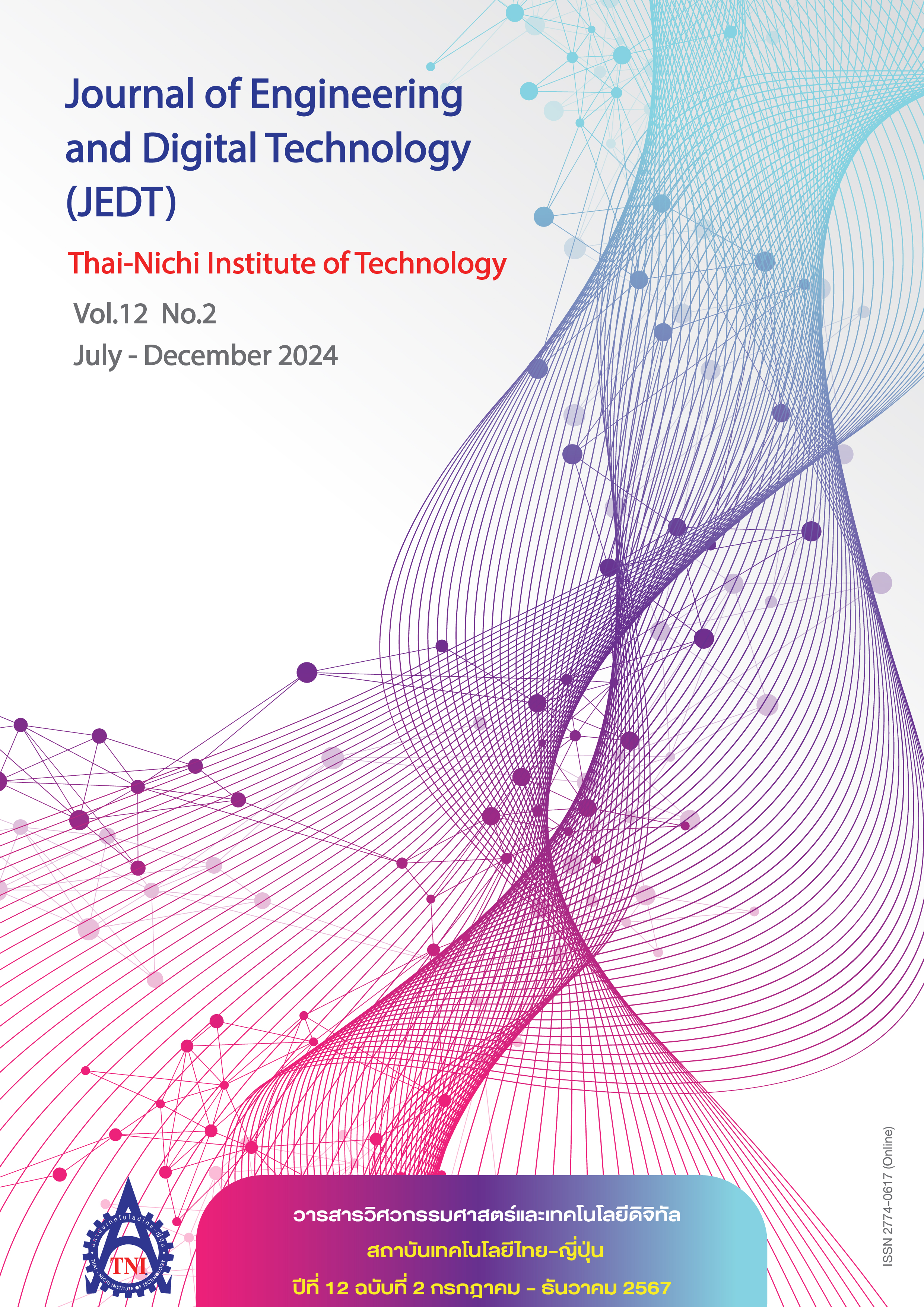Providing QoS for Multi-Class Traffic in IEEE 802.11 DCF with Constant Contention Window
Main Article Content
บทคัดย่อ
This paper presents two Medium Access Control algorithms named Limiting Accessible Slots (LAS) and Splitting Accessible Slots (SAS), which enable the IEEE 802.11 distributed coordination function (DCF) with Constant Contention Window protocol to support traffic with different quality of service requirements. LAS algorithm restricts slot access to group 1 users while group 2 users can access all slots. While SAS algorithm restricts slot access to both groups of users. Each group of users can only access the slots allocated to them. There are no slots that are shared by both groups of users. From the results, we found that each group of users has different average delay time for accessing the channel, so these algorithms can be used to provide different Quality of Service (QoS) for multi-class traffic. In conclusion, appropriately setting the accessible slots for group 1 and group 2 users is crucial for achieving the desired QoS levels, highlighting the importance of tailoring these parameters to the specific user distribution.
Article Details

อนุญาตภายใต้เงื่อนไข Creative Commons Attribution-NonCommercial-NoDerivatives 4.0 International License.
นโยบายการรับบทความ
กองบรรณาธิการวารสารสถาบันเทคโนโลยีไทย-ญี่ปุ่น มีความยินดีรับบทความจากอาจารย์ประจำ และผู้ทรงคุณวุฒิในสาขาวิศวกรรมศาสตร์และเทคโนโลยี ที่เขียนเป็นภาษาไทยหรือภาษาอังกฤษ ซึ่งผลงานวิชาการที่ส่งมาขอตีพิมพ์ต้องไม่เคยเผยแพร่ในสิ่งพิมพ์อื่นใดมาก่อน และต้องไม่อยู่ในระหว่างการพิจารณาของวารสารอื่นที่นำส่ง ดังนั้นผู้สนใจที่จะร่วมเผยแพร่ผลงานและความรู้ที่ศึกษามาสามารถนำส่งบทความได้ที่กองบรรณาธิการเพื่อเสนอต่อคณะกรรมการกลั่นกรองบทความพิจารณาจัดพิมพ์ในวารสารต่อไป ทั้งนี้บทความที่สามารถเผยแพร่ได้ประกอบด้วยบทความวิจัย ผู้สนใจสามารถศึกษาและจัดเตรียมบทความจากคำแนะนำสำหรับผู้เขียนบทความ
การละเมิดลิขสิทธิ์ถือเป็นความรับผิดชอบของผู้ส่งบทความโดยตรง บทความที่ได้รับการตีพิมพ์ต้องผ่านการพิจารณากลั่นกรองคุณภาพจากผู้ทรงคุณวุฒิและได้รับความเห็นชอบจากกองบรรณาธิการ
ข้อความที่ปรากฏภายในบทความของแต่ละบทความที่ตีพิมพ์ในวารสารวิชาการเล่มนี้ เป็น ความคิดเห็นส่วนตัวของผู้เขียนแต่ละท่าน ไม่เกี่ยวข้องกับสถาบันเทคโนโลยีไทย-ญี่ปุ่น และคณาจารย์ท่านอื่น ๆ ในสถาบัน แต่อย่างใด ความรับผิดชอบด้านเนื้อหาและการตรวจร่างบทความแต่ละบทความเป็นของผู้เขียนแต่ละท่าน หากมีความผิดพลาดใด ๆ ผู้เขียนแต่ละท่านจะต้องรับผิดชอบบทความของตนเองแต่ผู้เดียว
กองบรรณาธิการขอสงวนสิทธิ์มิให้นำเนื้อหา ทัศนะ หรือข้อคิดเห็นใด ๆ ของบทความในวารสารสถาบันเทคโนโลยีไทย-ญี่ปุ่น ไปเผยแพร่ก่อนได้รับอนุญาตจากผู้นิพนธ์ อย่างเป็นลายลักษณ์อักษร ผลงานที่ได้รับการตีพิมพ์ถือเป็นลิขสิทธิ์ของวารสารสถาบันเทคโนโลยีไทย-ญี่ปุ่น
ผู้ประสงค์จะส่งบทความเพื่อตีพิมพ์ในวารสารวิชาการ สถาบันเทคโนโลยีไทย-ญี่ปุ่น สามารถส่ง Online ที่ https://www.tci-thaijo.org/index.php/TNIJournal/ โปรดสมัครสมาชิก (Register) โดยกรอกรายละเอียดให้ครบถ้วนหากต้องการสอบถามข้อมูลเพิ่มเติมที่
- กองบรรณาธิการ วารสารสถาบันเทคโนโลยีไทย-ญี่ปุ่น
- ฝ่ายวิจัยและนวัตกรรม สถาบันเทคโนโลยีไทย-ญี่ปุ่น
เลขที่ 1771/1 สถาบันเทคโนโลยีไทย-ญี่ปุ่น ซอยพัฒนาการ 37-39 ถนนพัฒนาการ แขวงสวนหลวง เขตสวนหลวง กรุงเทพมหานคร 10250 ติดต่อกับคุณพิมพ์รต พิพัฒนกุล (02) 763-2752 , คุณจุฑามาศ ประสพสันติ์ (02) 763-2600 Ext. 2402 Fax. (02) 763-2754 หรือ E-mail: JEDT@tni.ac.th
เอกสารอ้างอิง
T. Zhang and Q. Zhu, “EVC-TDMA: An enhanced TDMA based cooperative MAC protocol for vehicular networks,” J. Commun. Netw., vol. 22, no. 4, pp. 316–325, Aug. 2020.
S. Li, Y. Liu, and J. Wang, “An efficient broadcast scheme for safety-related services in distributed TDMA-based VANETs,” IEEE Commun. Lett., vol. 23, no. 8, pp. 1432–1436, Aug. 2019.
M. Marey and H. Mostafa, “Code-aided modulation classification algorithm for multiuser uplink SC-FDMA systems,” IEEE Wireless Commun. Lett., vol. 10, no. 5, pp. 1023–1027, May 2021.
A. Kumar, S. Dwivedi, and A. K. Jagannatham, “GLRT based spectrum sensing for MIMO SC-FDMA cognitive radio networks,” IEEE Wireless Commun. Lett., vol. 4, no. 6, pp. 593–596, Dec. 2015.
L. Zhang and Y. Sun, “The optimal assignment of orthogonal polyphase sequences in CDMA Systems,” IEEE Commun. Lett., vol. 22, no. 1, pp. 109–112, Jan. 2018.
M. M. Farag and K. E. Ahmed, “Aggregated CDMA crossbar with hybrid ARQ for NoCs,” IEEE Access, vol. 10, no. 1, pp. 28206–28218, Mar. 2022.
Y. Wu, D. Wu, C. Yue, and Y. Yang, “Joint reservation and contention-based access for URLLC-enabled D2D communications,” IEEE Commun. Lett., vol. 26, no. 1, pp. 212–216, Jan. 2022.
B. Singh, O. Tirkkonen, Z. Li, and M. A. Uusitalo, “Contention-based access for ultra-reliable low latency uplink transmissions,” IEEE Wireless Commun. Lett., vol. 7, no. 2, pp. 182–185, Apr. 2018.
J. B. Seo and H. Jin, “Optimally controlled pure aloha systems for wireless sensor networks,” IEEE Commun. Lett., vol. 21, no. 11, pp. 2460–2463, Nov. 2017.
Y. Zhang, F. Guan, Y. H. Lo, F. Shu, and J. Li, “Optimal multichannel slotted ALOHA for deadline-constrained unicast systems,” IEEE Syst. J., vol. 13, no. 2, pp. 1308–1311, Jun. 2019.
X. Shao, Z. Sun, M. Yang, S. Gu, and Q. Guo, “NOMA-based irregular repetition slotted ALOHA for satellite networks,” IEEE Commun. Lett., vol. 23, no. 4, pp. 624–627, Apr. 2019.
R. Wang, J. Zhang, and X. Zou, “Performance analysis and optimization of IEEE 802.11 DCF with constant contention window,” in Proc. ISECS Int. Colloq. Comput. Commun. Control and Manage., Guangzhou, China, Aug. 2008, pp. 407–411.


